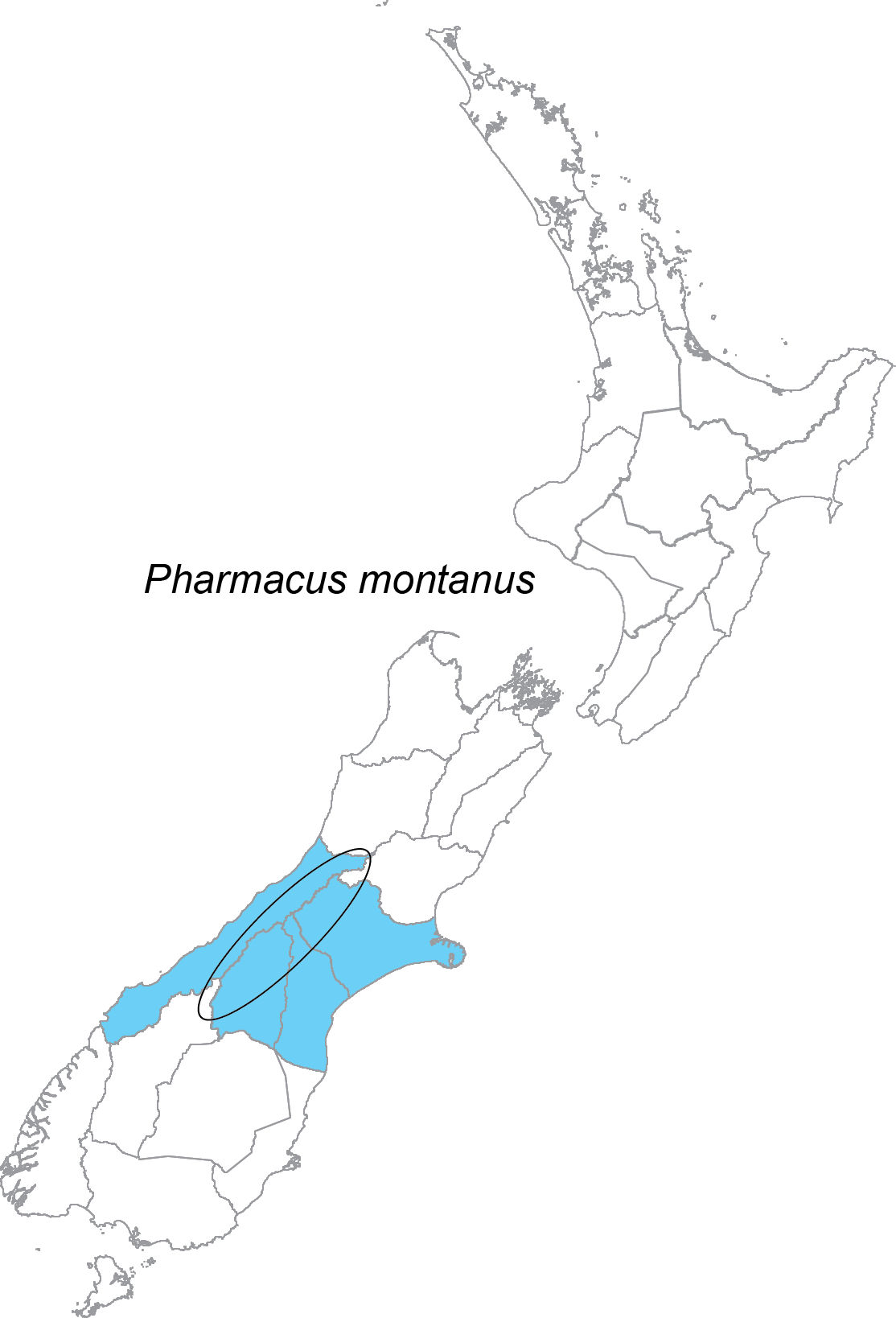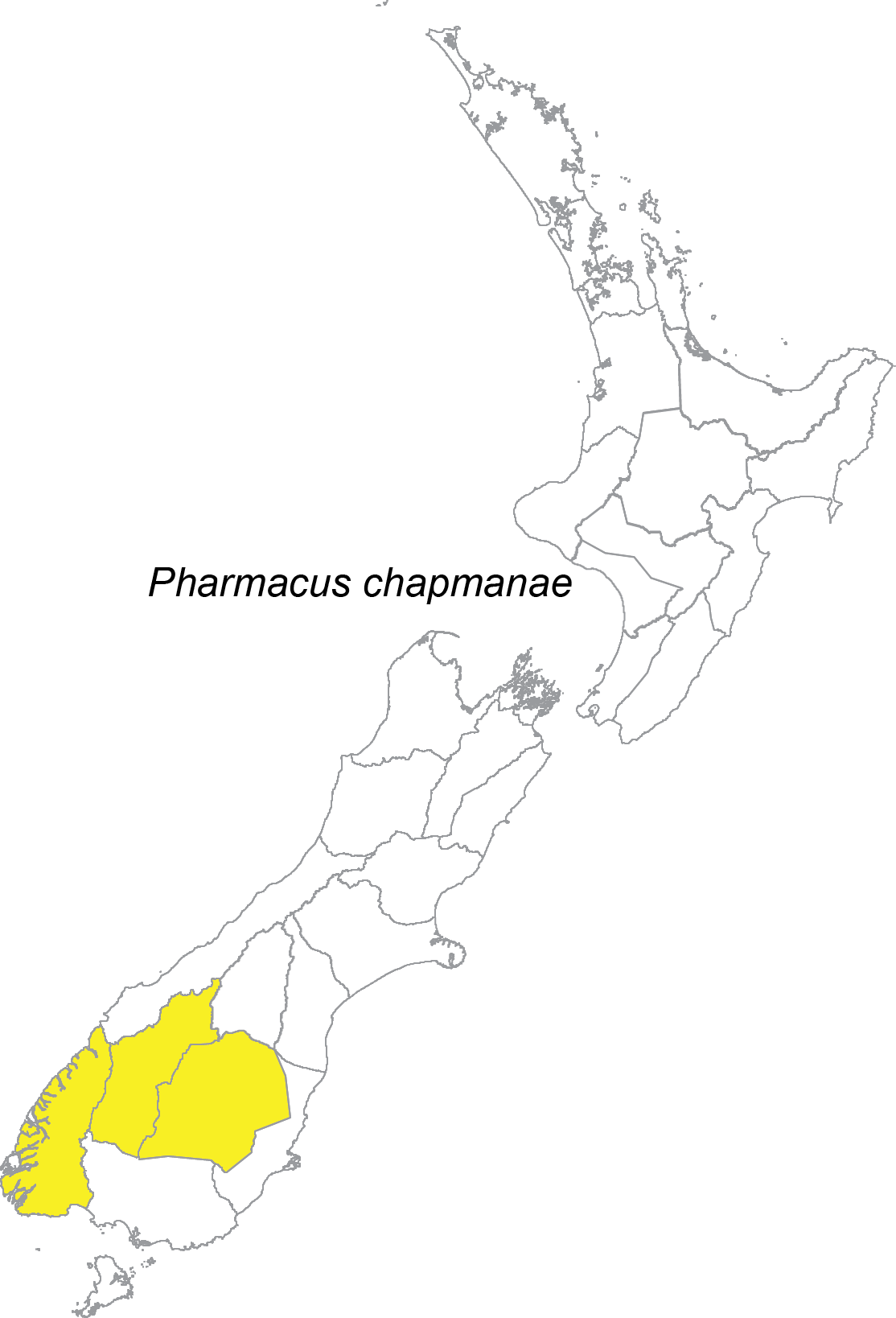Pharmacus montanus Pictet et Saussure, 1891
Body length: 14mm.
Ovipositor: 0.9x body length = 9.9mm deep reddish brown in colour.
Leg: body ratio
Fore: 1.7: 1 = 18.7mm
Mid: 1.7: 1 = 18.7mm
Hind: 2.6: 1 = 28.6mm
Locality: South Island. Mount Cook, Canterbury, 2134m asl, Piton Peak, Arrowsmith Range, Canterbury 2286m asl. Jollie Range, Canterbury, on rocks, 2134m asl. Two Thumb Range, Canterbury, 2134m asl. Haast Ridge, Mt. Cook, Canterbury, 1829m asl. Summit Mt. Van Bulow, Fritz Range, Westland, 2652m asl. Remarkable Ridge, Craigieburn Range, Canterbury, 1676m asl. Jamieson Saddle, Ben Ohau Range, Canterbury, 2134m asl. Fox Glacier, Westland, 2286m asl. Godley Valley, Canterbury, 2134m asl. Mt. D’Archiac, Godley Valley, Canterbury 2585m asl.
Notes: More closely related to P. brewsterensis and P. dumbletoni, but differs from them in darker coloration, greater number of teeth on ovipositor, shape of sub-genital plate of male and female, shape of suranal plate of male, fewer linear spines on hind femur than in P. brewsterensis.
Pharmacus dumbletoni Richards, 1972
Body length: 16mm
Leg: body ratio
Fore: 1.3: 1 = 1.3 x 16 = 20.8mm
Mid: 1.3: 1 = 1.3 x 16 = 20.8mm
Hind: 2.2: 1 = 2.2 x 16 = 35.2mm
Locality: South Island. Mt. Mahanga, Spenser Mountains, Nelson, 2134m asl.
Notes: Most closely related to P. montanus, but differs from it in lighter colouration, larger size, absence of linear spines on hind femora, shape of suranal plate of male, sub genital plate of male keeled distally only.
Pharmacus chapmanae Richards, 1972
Body length: 18 to 20 mm
Ovipositor: 0.6x body length = 12mm Deep reddish brown in colour.
Antennae: Very long and tapering. No spines present.
Leg: body ratio
Fore: 1.1: 1 = 19.8 - 22mm
Mid: 1.1: 1 = 19.8 - 22mm
Hind: 1.7: 1 = 30.6 – 34mm
Locality: Bevan Col, Matukituki, Otago. Gertrude Saddle, Homer, Otago. Diorite Valley, Mt. Angle, Forgotten Range, Fiordland, 1219m asl. Obelisk, Old Man Range, Otago, 1524m asl.
Notes: Closely related to P. montanus and P. brewsterensis. Separated from them by presence of linear spines on proximal segments of hind tarsi, much smaller styli, shape of sub genetical plates in males and females.
Pharmacus brewsterensis Richards, 1972
Body 17-18mm. Ovipositor 0.7 x body length.
Locality: Mt Brewster, Haast 1981m asl. Mt Burns, Hunter Mountains 114m asl (dubious).
Notes: Most similar to P. montanus, but differs from it, but lighter colouration, fewer teeth on ovipositor, greater number of linear spines on hind femur, and shape of subgenital plate. No male has been described.
|





P. chapmanae Old Man Ra.
newly moulted ©Steve Trewick |

